Beko WMI 71441, WMI 71641 User Manual
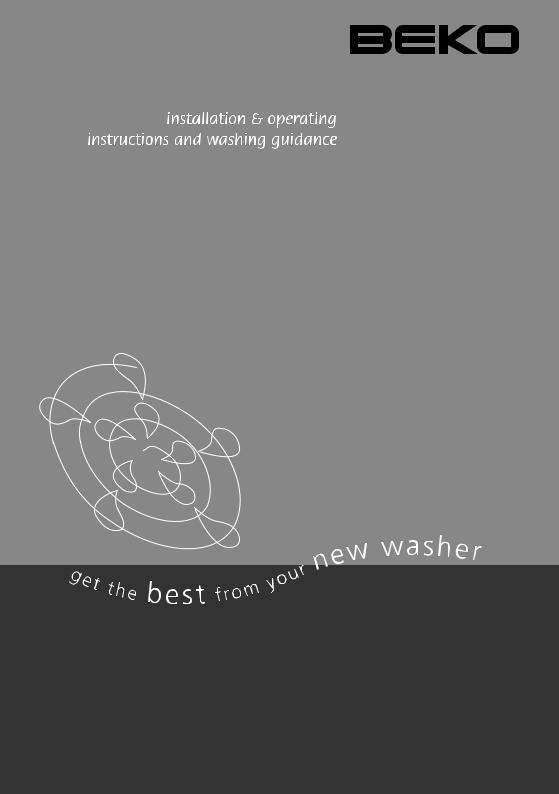
Automatic
Fully Integrated
Washing Machine
WMI 71641
WMI 71441
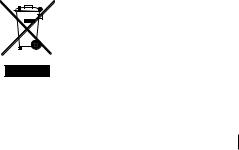
Please read this user manual first!
Dear Customer,
We hope that you get the best results from the product which has been manufactured in state-of-the-art plants and passed through a strict quality control procedure.
Therefore, please read the entire user manual carefully before using the product and keep it as a reference for future use. In case of transferring the product to someone else, give the manual as well.
The user manual will help you use your machine in a fast and safe way.
•Read the user manual before installing and starting your product.
•Always follow the safety instructions.
•Keep this user manual within easy reach for future reference.
•Read also the other documents supplied with the product.
Remember that this user manual is also applicable for several other models.
Differences between models will be identified in the manual.
2820521336_EN/300911.1013
Explanation of symbols
Throughout this user manual the following symbols are used:
C
AWarning for hazardous situations with regard to life and property. BWarning for electric shock.
This appliance’s packaging material is recyclable. Help recycle it and protect the environment by dropping it off in the municipal receptacles provided
for this purpose. Your appliance also contains a great amount of recyclable material. It is marked with this label to indicate the used appliances that should not be mixed with other waste. This way, the appliance recycling organised by your manufacturer will be done under the best possible conditions, in compliance with European Directive 2002/96/EC on Waste Electrical and Electronic Equipment. Contact your town hall or your retailer for the used appliance collection points closest to your home. We thank you doing your part to protect the environment.
2 EN

TABLE OF CONTENTS
1 |
Your washing machine |
4 |
Overview . . . . . . . . . . . . . . . . . . . . . . |
4 |
|
Technical specifications . . . . . . . . . . . |
5 |
|
2 |
Warnings |
6 |
General Safety . . . . . . . . . . . . . . . . . . 6 First Use . . . . . . . . . . . . . . . . . . . . . . . 6 Intended use . . . . . . . . . . . . . . . . . . . 6 Safety instructions . . . . . . . . . . . . . . . 7 If there are children in your house... . . 7
3 Installation |
8 |
Appropriate installation location . . . . . 8 Removing packaging reinforcement . . 8 Removing the transportation locks . . . 8 Connecting water supply . . . . . . . . . . 9 Connecting to the drain . . . . . . . . . . . 9 Adjusting the feet . . . . . . . . . . . . . . . 10
Raising the appliance . . . . . . . . . . . . 10 Electrical connection. . . . . . . . . . . . . 11 First use . . . . . . . . . . . . . . . . . . . . . . 12 Disposing of packaging material . . . . 12 Transportation of the product . . . . . . 12 Disposing of the old product. . . . . . . 12
4 Preparation |
13 |
Things to be done for energy saving . 13 Sorting the laundry . . . . . . . . . . . . . . 13 Preparing laundry for washing. . . . . . 13 Correct load capacity . . . . . . . . . . . . 14 Loading the laundry . . . . . . . . . . . . . 14 Detergents and softeners . . . . . . . . . 15 Tips for efficient washing . . . . . . . . . 17
5 Selecting a Program and |
|
Operating Your Machine |
18 |
Control panel . . . . . . . . . . . . . . . . . . 18 Display symbols . . . . . . . . . . . . . . . . 19 Turning the machine on . . . . . . . . . . 19 Program selection. . . . . . . . . . . . . . . 19
Additional programs . . . . . . . . . . . . 19 Special programs . . . . . . . . . . . . . . . 20 Temperature selection. . . . . . . . . . . . 21 Spin Speed selection . . . . . . . . . . . . 21 Program and consumption table. . . . 22
Auxiliary functions. . . . . . . . . . . . . . . 24 Time display . . . . . . . . . . . . . . . . . . . 24 Starting the Program . . . . . . . . . . . . 25 Progress of program. . . . . . . . . . . . . 25
Changing the selections after the program has started . . . . . . . . . . . . . 26
Switching the machine to standby mode . . . . . . . . . . . . . . . . . . . . . . . . 26
Child-proof lock . . . . . . . . . . . . . . . . 26 Ending the program through cancelling26 Program in rinse hold mode . . . . . . . 27 End of program . . . . . . . . . . . . . . . . 27
7 |
Troubleshooting |
31 |
|
|
|
8 |
Guarantee |
37 |
|
|
|
9 |
Service |
38 |
10BUILT-IN INSTALLATION 39
3 EN
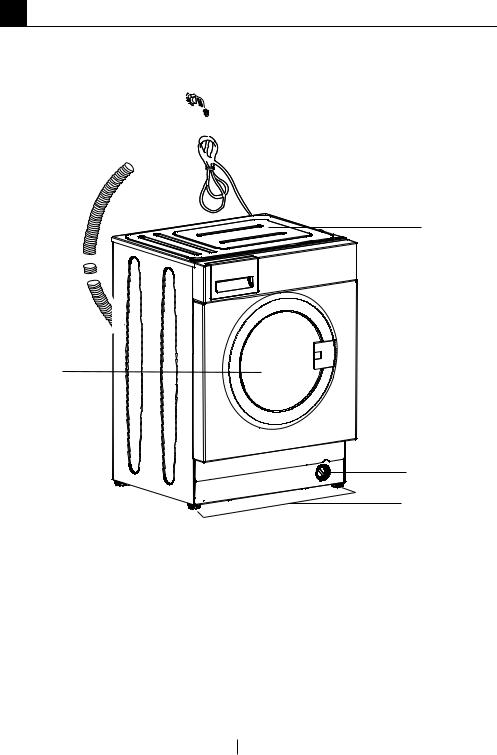
1 Your washing machine
Overview
 1 8
1 8 


2

 3 7
3 7 
6
4
5
1- Power cable |
5- Adjustable feet |
2- Top lid |
6- Loading door |
3- Control panel |
7- Detergent drawer |
4- Filter cap |
8- Drain hose |
4 EN

Technical specifications
Models (EN) |
WMI71641 |
WMI71441 |
Maximum dry laundry capacity (kg) |
7 |
7 |
|
|
|
Height (cm) |
82 |
82 |
|
|
|
Width (cm) |
60 |
60 |
|
|
|
Depth (cm) |
54 |
54 |
|
|
|
Net weight (±4 kg.) |
73 |
72 |
|
|
|
Electrical input (V/Hz) |
230 V / 50Hz |
230 V / 50Hz |
Total current (A) |
10 |
10 |
|
|
|
Total power (W) |
2200 |
2200 |
|
|
|
Spin speed (rpm max.) |
1600 |
1400 |
|
|
|
Stand-by mode power (W) |
1.40 |
1.40 |
|
|
|
Off-mode power (W) |
0.20 |
0.20 |
|
|
|
C Technical specifications may be changed without prior notice to improve the quality of the product.
C C
Figures in this manual are schematic and may not match the product exactly.
Values stated on the product labels or in the documentation accompanying it are obtained in laboratory conditions in accordance with the relevant standards.
Depending on operational and environmental conditions of the product, these values may vary.
5 EN

2 Warnings
Please read the following information. Otherwise, there may be the risk of personal injury or material damage.
Moreover, any warranty and reliability commitment will become void.
General Safety
•Never place your machine on a carpet covered floor. Otherwise, lack of airflow from below of your
machine may cause electrical parts to overheat. This may cause problems with your washing machine.
•If the power cable or mains plug is damaged you must call Authorized
Service for repair.
•Check water hoses for wear. Do not use old/used water inlet hoses. These may cause stains on your laundry.
•Fit the drain hose into the discharge housing securely to prevent any water leakage and to allow machine to take in and discharge water as required.
It is very important that the water intake and drain hoses are not folded, squeezed, or broken when the appliance is pushed into place after it is installed or cleaned.
•Your washing machine is designed to continue operating in the event of a power interruption. You cannot cancel any program by pressing the “On/Off button.” Your machine will not resume its program when the power restores. Press the “Start/Pause/Cancel” button for 3 seconds to cancel the program (See, Cancelling a Program)
•There may be some water in your machine when you receive it. This is from the quality control process and is normal. It is not harmful to your machine.
•Some problems you may encounter may be caused by the software. Press “Start/Pause/Cancel” button for 3 seconds to cancel the program set in your machine before calling the authorized service.
First Use
•To prepare your machine for washing, carry out your first washing process without loading your machine and with detergent under “Cottons 90°C” program.
•Ensure that the cold and hot water connections has been made correctly when installing your machine. Otherwise, your laundry may come out hot at the end of the washing process and may wear out.
•If the current fuse or circuit breaker is less than 16 Amperes, please have a qualified electrician install a 16
Ampere fuse or circuit breaker.
•While using with or without a transformer, do not neglect to have the grounding installation laid by a qualified electrician. Our company shall not be liable for any damages that may arise when the machine is used on a line without grounding.
•To make your machine ready for use, please be sure that the tap water supply and water drainage systems are appropriate before calling the authorized service. If they are not, call a qualified plumber to have any necessary arrangements carried out.
Intended use
•This product has been designed for home use.
•The appliance may only be used for washing and rinsing of textiles that are marked accordingly.
•Only detergents, softeners and supplements suitable for washing machines may be used.
•Observe the care instructions labelled on textile products and any other instructions given by companies that produce detergents for your machine.
•This appliance is not intended for use by persons (including children) with reduced physical, sensory or mental capabilities, or lack of experience and knowledge, unless they have been given supervision or instruction
6 EN

concerning use of the appliance by a person responsible for their safety.
Safety instructions
•This appliance must be connected to an earthed outlet protected by a fuse of suitable capacity.
•The supply and draining hoses must always be securely fastened and remain in an undamaged state.
•Fit the draining hose to a washbasin or bathtub securely before starting up your machine. There may be a risk of being scalded due to high washing temperatures!
•Never open the door or remove the filter while there is still water in the drum. Otherwise, there may be the risk of flooding and possible injury due to the hot water.
•Never force open the locked door! The door will be ready to open just a few minutes after the washing cycle comes to an end.
•Unplug the machine when it is not in use.
•Never wash down the appliance with a water hose! There is the risk of electric shock! Always disconnect from the mains by unplugging before cleaning.
•Never touch the plug with wet hands.
Never unplug by pulling on the cable, always pull out from the plug only. Do not operate the machine if the power cord or plug is damaged.
•Never attempt to repair the machine yourself. Otherwise, you may be putting yours and other’s lives in danger.
•For malfunctions that cannot be solved by information in the operating manual:
Turn off the machine, unplug it, turn off the water tap and contact an authorized service agent.
If there are children
in your house...
•Electrical appliances may be dangerous for the children. Keep children away from the machine when
it is operating. Do not let them tamper with the machine.
•Close the door when you leave the area where the machine is located.
•Store all detergents in a safe place out of reach of the children.
7 EN
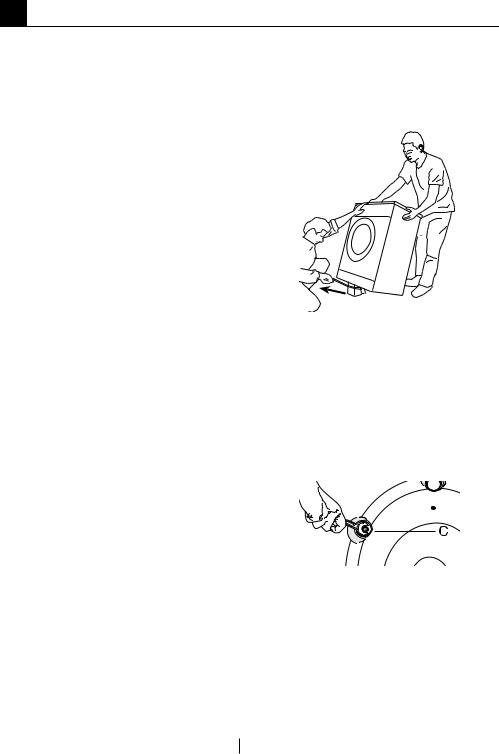
3 Installation
Refer to the nearest Authorised Service Agent for installation of the product. To make the product ready for use, review the information in the user manual and make sure that the electricity, tap water supply and water drainage systems are appropriate before calling the Authorized Service Agent. If they are not, call a qualified technician and plumber to have any necessary arrangements carried out.
C Preparation of the location and electrical, tap water and waste water installations at the place of installation is under customer's responsibility.
BInstallation and electrical connections of the product must be carried out by the Authorized Service Agent.
Manufacturer shall not be held liable for damages that may arise from procedures carried out by unauthorized persons.
APrior to installation, visually check if the product has any defects on it. If so, do not have it installed. Damaged products cause risks for your safety.
C Make sure that the water inlet and discharge hoses as well as the power cable are not folded, pinched or crushed while pushing the product into its place after installation or cleaning procedures.
Appropriate installation location
•Place the machine on a rigid floor.
Do not place it on a long pile rug or similar surfaces.
•Total weight of the washing machine and the dryer -with full loadwhen they are placed on top of each other reaches to approx. 180 kilograms. Place the product on a solid and flat floor that has sufficient load carrying capacity!
•Do not place the product on the power cable.
•Do not install the product at places where temperature may fall below 0ºC.
•Place the product at least 1 cm away from the edges of other furniture.
Removing packaging reinforcement
Tilt the machine backwards to remove the packaging reinforcement. Remove the packaging reinforcement by pulling the ribbon.
Removing the transportation locks
ADo not remove the transportation locks before taking out the packaging reinforcement.
ARemove the transportation safety bolts before operating the washing machine, otherwise, the product will be damaged.
1.Loosen all the bolts with a spanner until they rotate freely (C).
2.Remove transportation safety bolts by turning them gently.
8 EN
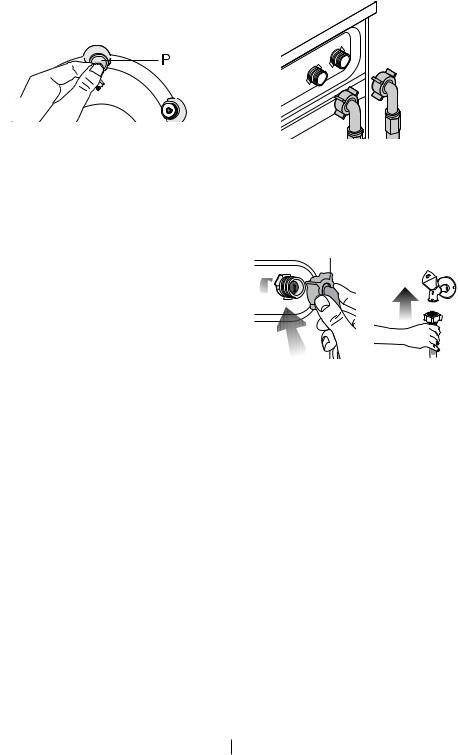
3.Attach the plastic covers supplied in the User Manual bag into the holes on the rear panel. (P)
C Keep the transportation safety bolts in a safe place to reuse when the washing machine needs to be moved again in the future.
C Never move the product without the transportation safety bolts properly fixed in place!
Connecting water supply
C The water supply pressure required to run the product is between 1 to 10 bars (0.1 – 10 MPa). It is necessary to have 10 – 80 liters of water flowing from the fully open tap in one minute to have your machine run smoothly.
Attach a pressure reducing valve if water pressure is higher.
C If you are going to use the double water-inlet product as a single (cold) water-inlet unit, you must install the supplied stopper to the hot water valve before operating the product.
(Applies for the products supplied with a blind stopper group.)
C If you want to use both water inlets of the product, connect the hot water hose after removing the stopper and gasket group from the hot water valve. (Applies for the products supplied with a blind stopper group.)
AModels with a single water inlet should not be connected to the hot water tap. In such a case the laundry will get damaged or the product will switch to protection mode and will not operate.
ADo not use old or used water inlet hoses on the new product. It may cause stains on your laundry.
1.Connect the special hoses supplied with the product to the water inlets on the product. Red hose (left) (max.
90 ºC) is for hot water inlet, blue hose (right) (max. 25 ºC) is for cold water inlet.
AEnsure that the cold and hot water connections are made correctly when installing the product. Otherwise, your laundry will come out hot at the end of the washing process and wear out.
2.Tighten all hose nuts by hand. Never use a wrench when tightening the nuts.
3.Open the taps completely after making the hose connection to check for water leaks at the connection points. If any leaks occur, turn off the tap and remove the nut. Retighten the nut carefully after checking the seal. To prevent water leakages and damages caused by them, keep the taps closed when the machine is not in use.
Connecting to the drain
•The end of the drain hose must be directly connected to the wastewater drain or to the washbasin.
AYour house will be flooded if the hose comes out of its housing during water discharge. Moreover, there is risk of scalding due to high washing temperatures! To prevent
such situations and to ensure smooth water intake and discharge of the machine, fix the end of the discharge hose tightly so that it cannot come out.
9 EN
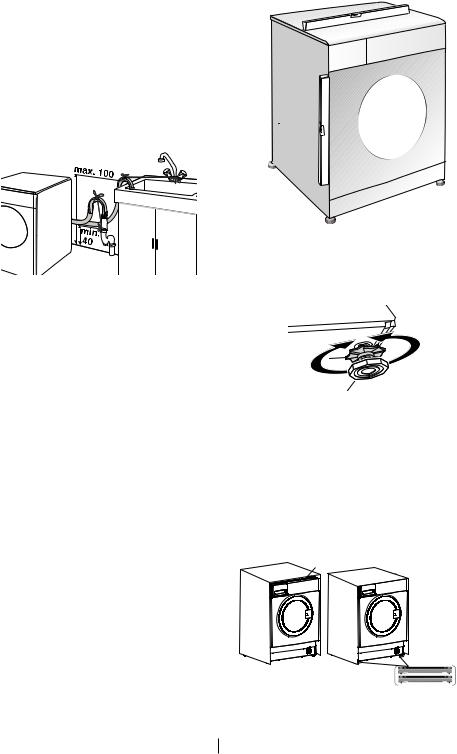
•The hose should be attached to a height of at least 40 cm, and 100 cm at most.
•In case the hose is elevated after laying it on the floor level or close to the ground (less than 40 cm above the ground), water discharge becomes more difficult and the laundry may come out excessively wet. Therefore, follow the heights described in the figure.
•To prevent flowing of dirty water back into the machine and to allow for easy discharge, do not immerse the hose end into the dirty water or drive it in the drain more than 15 cm. If it is too long, cut it short.
•The end of the hose should not be bent, it should not be stepped on and the hose must not be pinched between the drain and the machine.
•If the length of the hose is too short, use it by adding an original extension hose. Length of the hose may not be longer than 3.2 m. To avoid water leak failures, the connection between the extension hose and the drain hose of the product must be fitted well with an appropriate clamp as not to come off and leak.
Adjusting the feet
AIn order to ensure that the product operates more silent and vibrationfree, it must stand level and balanced on its feet. Balance the machine by adjusting the feet. Otherwise, the product may move from its place and cause crushing and vibration
problems.
1.Loosen the lock nuts on the feet by hand.
2.Adjust the feet until the product stands level and balanced.
3.Tighten all lock nuts again by hand.
ADo not use any tools to loosen the lock nuts. Otherwise, they will get damaged.
Raising the appliance
In order to raise the appliance to eliminate the gap below the worktop, you will need to order special optional kit.
Please call Beko Spare Part Department. (0845 6004911) and see built-in installation section.
Gap
Without optional |
With optional raising |
raising feet. |
feet. Minimum |
|
height=55 mm, max Service Ref. No. 1493 |
|
height=65mm |
10 EN
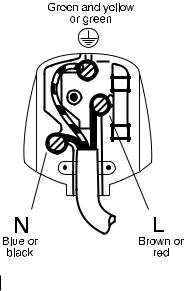
Electrical connection
Connect the product to a grounded outlet protected by a fuse complying with the values in the "Technical specifications" table. Our company shall not be liable
for any damages that will arise when the product is used without grounding in accordance with the local regulations.
•Connection must comply with national regulations.
•Power cable plug must be within easy reach after installation.
•The voltage and allowed fuse or breaker protection are specified in the “Technical specifications” section. If the current value of the fuse or breaker in the house is less than 13
Amps, have a qualified electrician install a 13 Amp fuse.
•The specified voltage must be equal to your mains voltage.
•Do not make connections via extension cables or multi-plugs.
BDamaged power cables must be replaced by the Authorized Service Agents.
Electrical requirements
Before you insert the plug into the wall socket make sure that the voltage and the frequency shown in the rating label corresponds to your electricity supply.
We recommend that this appliance be connected to the mains supply via a suitable switched and fused socket in a readily accessible position.
Should the mains lead of the appliance become damaged or need replacing at any time, it must be replaced by a special purpose made mains lead which can only be obtained from a Authorised Service Agent.
BThis appliance must be earthed
If the fitted moulded plug is not suitable for your socket, then the plug should be cut off and an appropriate plug fitted.
Destroy the old plug, which is cut off as a plug with a bared cord could cause a shock hazard if inserted into a socket elsewhere in the house.
The moulded plug on this appliance incorporates a 13A fuse. Should the fuse
need to be replaced an ASTA approved
BS1362 fuse of the same rating must be used. Do not forget to refit the fuse cover. In the event of losing the fuse cover, the plug must not be used until a replacement fuse cover has been fitted. Colour of the replacement fuse cover must be the same colour as that visible on the pin face of the plug. Fuse covers are available from any good electrical store.
Important
Fitting a different plug
As the colours of the wires in the mains lead of this appliance may not correspond with the coloured markings identifying the terminals on your plug, proceed as follows:
1Connect the green - yellow or green (earth) wire to the terminal in the plug marked ‘E’ or with the symbol f or coloured green and yellow or green.
2Connect the blue (neutral) wire to the terminal in the plug marked ‘N’ or coloured black.
3Connect the brown (live) wire to the terminal in the plug marked ‘L’ or coloured red.
With the alternative plugs a 13A fuse must be fitted either in the plug or adaptor or in the main fuse box. If in doubt contact a qualified electrician.
11 EN
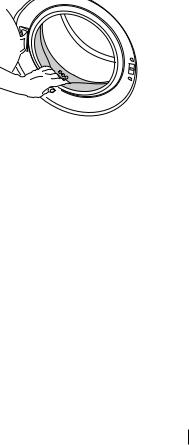
First use
Before starting to use the product, make sure that all preparations are made in accordance with the instructions in sections "Important safety instructions" and "Installation".
To prepare the product for washing laundry, perform first operation in Drum Cleaning programme. If your machine is not featured with Drum Cleaning programme, use Cottons-90
programme and select Additional Water or Extra Rinse auxiliary functions as well. Before starting the programme, put max. 100 g of powder antilimescale into the main wash detergent compartment (compartment nr. II). If the anti-limescale is in tablet form, put only one tablet into compartment nr. II. Dry the inside of the bellow with a clean piece of cloth after the programme has come to an end.
C Use an anti-limescale suitable for the washing machines.
C Some water might have remained in the product due to the quality control processes in the production. It is not harmful for the product.
Disposing of packaging material
Packaging materials are dangerous to children. Keep packaging materials in a safe place away from reach of the children.
Packaging materials of the product are manufactured from recyclable materials. Dispose of them properly and sort
in accordance with recycled waste instructions. Do not dispose of them with normal domestic waste.
Transportation of the product
1.Unplug the product before transporting it.
2.Remove water drain and water supply connections.
3.Drain the remaining water in the product completely; see, "Draining remaining water and cleaning the pump filter".
4.Install transportation safety bolts in the reverse order of removal procedure; see, "Removing the transportation locks".
C Never move the product without the transportation safety bolts properly fixed in place!
Disposing of the old product
Dispose of the old product in an environmentally friendly manner.
Refer to your local dealer or solid waste collection centre in your area to learn how to dispose of your product.
For children's safety, cut the power cable and break the locking mechanism of the loading door so that it will be nonfunctional before disposing of the product.
12 EN
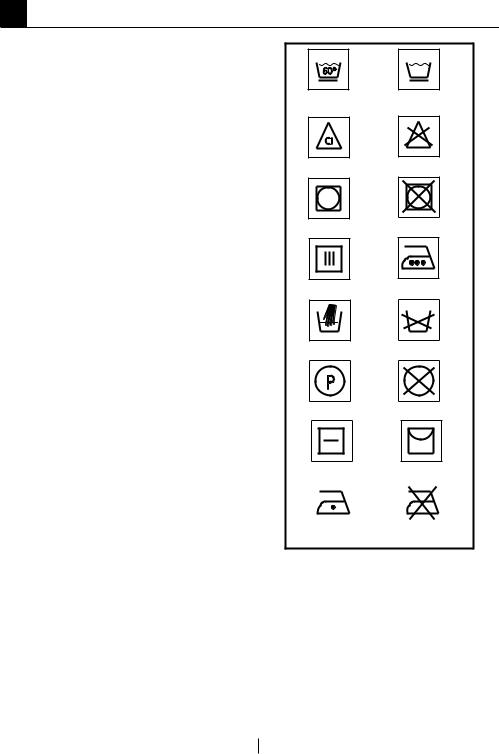
4 Preparation
Things to be done for energy saving
Following information will help you use the product in an ecological and energyefficient manner.
•Operate the product in the highest capacity allowed by the programme you have selected, but do not overload; see, "Programme and consumption table".
•Always follow the instructions on the detergent packaging.
•Wash slightly soiled laundry at low temperatures.
•Use faster programmes for small quantities of lightly soiled laundry.
•Do not use prewash and high temperatures for laundry that is not heavily soiled or stained.
•If you plan to dry your laundry in a dryer, select the highest spin speed recommended during washing process.
•Do not use detergent in excess of the amount recommended on the detergent package.
Sorting the laundry
•Sort laundry according to type of fabric, colour, and degree of soiling and allowable water temperature.
•Always obey the instructions given on the garment tags.
Washing water |
Wash with sensitive, |
temperature |
.short programmes |
Bleach can be |
Do not use bleach |
used |
|
Suitable for drier |
Do not dry with drier |
Hang without |
Can be ironed with |
spinning |
hot iron |
Non machine-washable |
Do not wash |
Dry-cleanable |
Do not dry-clean |
Dry horizontally |
Dry on a hanger |
|
|
|
|
Can be ironed |
Do not iron |
||
with warm iron |
|
||
Preparing laundry for washing
•Laundry items with metal attachments such as, underwired bras, belt buckles or metal buttons will damage the machine. Remove the metal pieces or wash the clothes by putting them in a laundry bag or pillow case.
13 EN
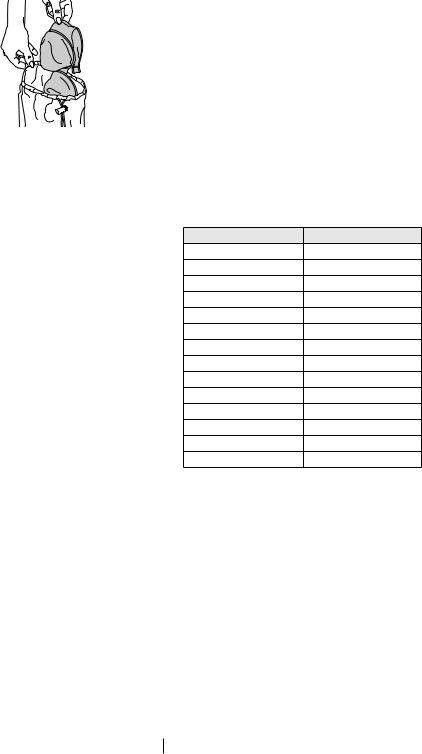
•Take out all substances in the pockets such as coins, pens and paper clips, and turn pockets inside out and brush. Such objects may damage the product or cause noise problem.
•Put small size clothes such as infant's socks and nylon stockings in a laundry bag or pillow case.
•Place curtains in without compressing them. Remove curtain attachment items.
•Fasten zippers, sew loose buttons and mend rips and tears.
•Wash “machine washable” or “hand washable” labeled products only with an appropriate programme.
•Do not wash colours and whites together. New, dark coloured cottons release a lot of dye. Wash them separately.
•Tough stains must be treated properly before washing. If unsure, check with a dry cleaner.
•Use only dyes/colour changers and limescale removers suitable for machine wash. Always follow the instructions on the package.
•Wash trousers and delicate laundry turned inside out.
•Keep laundry items made of Angora wool in the freezer for a few hours before washing. This will reduce pilling.
•Laundry that are subjected to materials such as flour, lime dust, milk powder, etc. intensely must be shaken off before placing into the machine. Such dusts and powders on the laundry may build up on the inner parts of the machine in time and can cause damage.
Correct load capacity
The maximum load capacity depends on the type of laundry, the degree of soiling and the washing programme desired.
The machine automatically adjusts the amount of water according to the weight of the loaded laundry.
AFollow the information in the “Programme and consumption table”. When overloaded, machine's washing performance will drop. Moreover, noise and vibration problems may occur.
Laundry types and their average weights in the following table are given as examples.
Laundry type |
Weight (g) |
Bathrobe |
1200 |
Napkin |
100 |
Duvet cover |
700 |
Bed Sheet |
500 |
Pillowcase |
200 |
Tablecloth |
250 |
Towel |
200 |
Hand towel |
100 |
Evening gown |
200 |
Underclothing |
100 |
Men’s overalls |
600 |
Men’s shirt |
200 |
Men’s pajamas |
500 |
Blouses |
100 |
Loading the laundry
•Open the loading door.
•Place laundry items loosely into the machine.
•Push the loading door to close until you hear a locking sound. Ensure that no items are caught in the door.
C The loading door is locked while a programme is running. The door can only be opened a while after the programme comes to an end.
AIn case of misplacing the laundry, noise and vibration problems may occur in the machine.
14 EN

Detergents and softeners
Detergent Drawer
Detergent drawer of your washing machine consists of four different compartments for powder main wash detergent, liquid main wash detergent, liquid softener and powder pre-wash detergent. Each of these laundry additives are dispensed automatically in the relevant time during the washing Programme.
Do not place the laundry additives directly into the drum. Always use the detergent drawer.
Do not close the drawer too fast after putting the laundry additives. This may cause the additives be dispensed early, creating unsatisfactory washing results and fabric damage.
C Do not open the drawer during washing Programme.
The detergent drawer compartments are indicated below:
1)Left compartment with number “II” (Main wash compartment for powder detergent or powder bleach/stain remover)
2)Left compartment with number “II  ” (Main wash compartment for liquid detergent or liquid stain remover)
” (Main wash compartment for liquid detergent or liquid stain remover)
3)Middle compartment with number “I” (pre-wash compartment for powder detergent, powder stain remover or liquid bleach - liquid bleach must be added either during the pre-wash
or during the first rinsing step of the washing Programme). Liquid bleach must be added manually while the machine takes in water.
4)Right compartment with “ ” symbol (liquid softener compartment)
” symbol (liquid softener compartment)
 2
2
 1
1











 3 4
3 4








(II) Main Wash Compartment
Before starting the washing Programme, put powder detergent into the left compartment with number “II”. Use the detergent manufacturer’s measuring cup and follow the instructions on the package. Powder bleach/stain remover must also be put into this compartment.
Put the liquid detergent into the main wash compartment with number “II  ” before starting the washing Programme. Liquid stain remover must be put into this compartment.
” before starting the washing Programme. Liquid stain remover must be put into this compartment.
Put the suggested amount of liquid detergent into the left compartment with “II  ” symbol and dilute it to the maximum filling level line (max. II
” symbol and dilute it to the maximum filling level line (max. II  ) with warm water.
) with warm water.
Particularly the concentrated detergents must be diluted with warm water; otherwise, the siphon may get clogged in time.
Do not fill the detergent above the maximum filling level line; otherwise the excess amount of detergent will reach the laundry without water and may cause stains on the garments.In this case you will need to refill the compartment. Do not pour the detergent onto the laundry directly since this may cause stains on the garments.
Liquid Softener Compartment
Put the suggested amount of liquid softener into the right compartment with “ ” symbol and dilute it to the maximum filling level line (max.
” symbol and dilute it to the maximum filling level line (max.  ) with warm water.
) with warm water.
15 EN

Particularly the concentrated softeners must be diluted with warm water; otherwise, the siphon may get clogged in time.
Do not fill the softener above the maximum filling level line; otherwise the excess amount of softener will get mixed with the washing water and you will need to refill the compartment. Do not pour the softener onto the laundry directly since this may cause stains on the garments.
Liquid softener will be dispensed automatically at the final rinsing step of the washing Programme.
(I) Pre-Wash Compartment
Put the powder pre-wash detergent or powder stain remover into the middle compartment with number “I”.
You can also put liquid bleach into this compartment while the machine takes in water during pre-wash or first rinsing step. Adding the liquid bleach while the machine takes in water allows it to be diluted before it is poured onto the laundry.
You must select extra rinsing option if you use liquid bleach in a washing
Programme. Bleach must be removed from the laundry with rinsing; otherwise it may cause itching on the skin.
C Read the dosage instructions and label of your garments carefully before using the liquid bleach.
Starch
•Add liquid starch, powder starch or the dyestuff into the softener compartment as instructed on the package.
•Never use fabric softener and starch together in the same washing cycle.
•Wipe the inside of the drum after using starch.
Bleaches
If you are going to use regular bleach in your machine, it is suggested to select a Programme with pre-wash step and add the bleach at the beginning of the pre-wash without putting detergent into
the pre-wash compartment. Alternatively, it is suggested to select a Programme with extra rinsing and add the bleach while the machine takes in water from the detergent drawer in the first rinsing step. Bleach should not be mixed with
detergent. Since the bleach may cause irritation on skin, little amounts must be used and rinsed thoroughly. Do not pour bleach directly onto the laundry and do not use it with colour laundry.
When using oxygen based bleach, follow the instructions on the package and select a Programme at low temperature. Oxygen based bleach can be used together with the detergent. However, if it is not at the same thickness with the detergent, then it must be added from the compartment number “II” right after the detergent foams with water.
Eliminating lime formation
•When required, use only appropriate lime removers developed specifically for washing machines and always follow the instructions on the package.
16 EN
